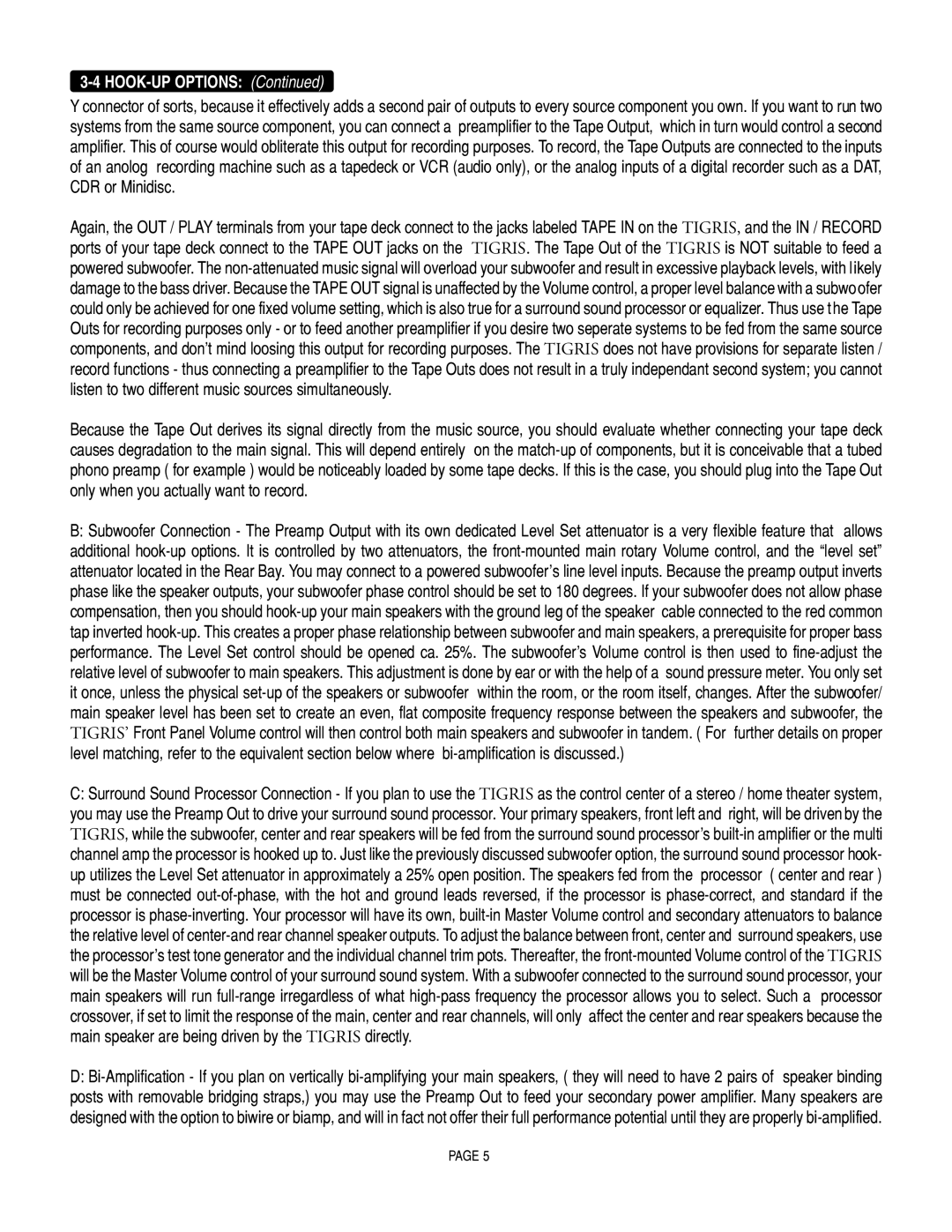3-4 HOOK-UP OPTIONS: (Continued)
Y connector of sorts, because it effectively adds a second pair of outputs to every source component you own. If you want to run two systems from the same source component, you can connect a preamplifier to the Tape Output, which in turn would control a second amplifier. This of course would obliterate this output for recording purposes. To record, the Tape Outputs are connected to the inputs of an anolog recording machine such as a tapedeck or VCR (audio only), or the analog inputs of a digital recorder such as a DAT, CDR or Minidisc.
Again, the OUT / PLAY terminals from your tape deck connect to the jacks labeled TAPE IN on the TIGRIS, and the IN / RECORD ports of your tape deck connect to the TAPE OUT jacks on the TIGRIS. The Tape Out of the TIGRIS is NOT suitable to feed a powered subwoofer. The non-attenuated music signal will overload your subwoofer and result in excessive playback levels, with likely damage to the bass driver. Because the TAPE OUT signal is unaffected by the Volume control, a proper level balance with a subwoofer could only be achieved for one fixed volume setting, which is also true for a surround sound processor or equalizer. Thus use the Tape Outs for recording purposes only - or to feed another preamplifier if you desire two seperate systems to be fed from the same source components, and don’t mind loosing this output for recording purposes. The TIGRIS does not have provisions for separate listen / record functions - thus connecting a preamplifier to the Tape Outs does not result in a truly independant second system; you cannot listen to two different music sources simultaneously.
Because the Tape Out derives its signal directly from the music source, you should evaluate whether connecting your tape deck causes degradation to the main signal. This will depend entirely on the match-up of components, but it is conceivable that a tubed phono preamp ( for example ) would be noticeably loaded by some tape decks. If this is the case, you should plug into the Tape Out only when you actually want to record.
B:Subwoofer Connection - The Preamp Output with its own dedicated Level Set attenuator is a very flexible feature that allows additional hook-up options. It is controlled by two attenuators, the front-mounted main rotary Volume control, and the “level set” attenuator located in the Rear Bay. You may connect to a powered subwoofer’s line level inputs. Because the preamp output inverts phase like the speaker outputs, your subwoofer phase control should be set to 180 degrees. If your subwoofer does not allow phase compensation, then you should hook-up your main speakers with the ground leg of the speaker cable connected to the red common tap inverted hook-up. This creates a proper phase relationship between subwoofer and main speakers, a prerequisite for proper bass performance. The Level Set control should be opened ca. 25%. The subwoofer’s Volume control is then used to fine-adjust the relative level of subwoofer to main speakers. This adjustment is done by ear or with the help of a sound pressure meter. You only set it once, unless the physical set-up of the speakers or subwoofer within the room, or the room itself, changes. After the subwoofer/ main speaker level has been set to create an even, flat composite frequency response between the speakers and subwoofer, the TIGRIS’ Front Panel Volume control will then control both main speakers and subwoofer in tandem. ( For further details on proper level matching, refer to the equivalent section below where bi-amplification is discussed.)
C:Surround Sound Processor Connection - If you plan to use the TIGRIS as the control center of a stereo / home theater system, you may use the Preamp Out to drive your surround sound processor. Your primary speakers, front left and right, will be driven by the TIGRIS, while the subwoofer, center and rear speakers will be fed from the surround sound processor’s built-in amplifier or the multi channel amp the processor is hooked up to. Just like the previously discussed subwoofer option, the surround sound processor hook- up utilizes the Level Set attenuator in approximately a 25% open position. The speakers fed from the processor ( center and rear ) must be connected out-of-phase, with the hot and ground leads reversed, if the processor is phase-correct, and standard if the processor is phase-inverting. Your processor will have its own, built-in Master Volume control and secondary attenuators to balance the relative level of center-and rear channel speaker outputs. To adjust the balance between front, center and surround speakers, use the processor’s test tone generator and the individual channel trim pots. Thereafter, the front-mounted Volume control of the TIGRIS will be the Master Volume control of your surround sound system. With a subwoofer connected to the surround sound processor, your main speakers will run full-range irregardless of what high-pass frequency the processor allows you to select. Such a processor crossover, if set to limit the response of the main, center and rear channels, will only affect the center and rear speakers because the main speaker are being driven by the TIGRIS directly.
D:Bi-Amplification - If you plan on vertically bi-amplifying your main speakers, ( they will need to have 2 pairs of speaker binding posts with removable bridging straps,) you may use the Preamp Out to feed your secondary power amplifier. Many speakers are designed with the option to biwire or biamp, and will in fact not offer their full performance potential until they are properly bi-amplified.
